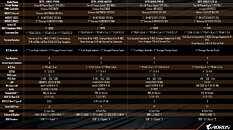- Joined
- Oct 9, 2007
- Messages
- 47,448 (7.50/day)
- Location
- Hyderabad, India
| System Name | RBMK-1000 |
|---|---|
| Processor | AMD Ryzen 7 5700G |
| Motherboard | ASUS ROG Strix B450-E Gaming |
| Cooling | DeepCool Gammax L240 V2 |
| Memory | 2x 8GB G.Skill Sniper X |
| Video Card(s) | Palit GeForce RTX 2080 SUPER GameRock |
| Storage | Western Digital Black NVMe 512GB |
| Display(s) | BenQ 1440p 60 Hz 27-inch |
| Case | Corsair Carbide 100R |
| Audio Device(s) | ASUS SupremeFX S1220A |
| Power Supply | Cooler Master MWE Gold 650W |
| Mouse | ASUS ROG Strix Impact |
| Keyboard | Gamdias Hermes E2 |
| Software | Windows 11 Pro |
GIGABYTE today showed off its upcoming AMD X670E and X670 chipset-based Socket AM5 motherboard lineup for the Ryzen 7000-series "Zen 4" desktop processors due to launch in September. Given AMD's push for PCI-Express Gen 5 connectivity beyond just the PEG slot, the new X670E chipset, with multiple Gen 5 M.2 slots, covers the upper end of the GIGABYTE AORUS motherboard series, with the X670E AORUS Xtreme and the X670E AORUS Master. The lower-end of the lineup is based on the X670, with the AORUS Pro and AORUS Elite tiers.
Both the X670E and X670 offer at least one PCI-Express 5.0 x16 slot (which can be further split into two x8 Gen 5 slots); and at least one PCI-Express 5.0 x4 M.2 NVMe slot wired to the AM5 processor. The X670E is differentiated in having an additional Gen 5 M.2 slot that is wired to the SoC, besides downstream Gen 5 PCIe connectivity from the chipset. The AORUS Xtreme leads the pack with a monstrous 18-phase VRM that uses 105 A DrMOS, an 8-layer PCB, four Gen 5 M.2 slots, the highest-grade onboard audio with ESS-made headphones DAC, AQuantia 10 GbE, WiFi 6E, and a plethora of overclocker-friendly features.




The X670E AORUS Master is the second-best from the GIGABYTE stable, with a 16-phase VRM that uses the same 105 A DrMOS as the AORUS Xtreme, two Gen 5 M.2 slots instead of four on the AORUS Xtreme; 2.5 GbE instead of 10 GbE, and a purely Realtek ALC1220-based onboard audio solution. A step down from here, and you get the X670 AORUS Pro AX, with its 6-layer PCB, a 16-phase VRM that uses 90 A DrMOS, a single Gen 5 M.2 slot wired to the SoC, 2.5 GbE and WiFi 6E; but a based ALC897-based onboard audio. The most affordable board of the lot is the X670 AORUS Elite AX, with its 16-phase VRM that uses 70 A power stages, a similar expansion slot loadout to the AORUS Pro AX, and interestingly, an AMD-MediaTek made WiFi 6E solution (the others in the series use an Intel AX210. The finer specs follow.

View at TechPowerUp Main Site
Both the X670E and X670 offer at least one PCI-Express 5.0 x16 slot (which can be further split into two x8 Gen 5 slots); and at least one PCI-Express 5.0 x4 M.2 NVMe slot wired to the AM5 processor. The X670E is differentiated in having an additional Gen 5 M.2 slot that is wired to the SoC, besides downstream Gen 5 PCIe connectivity from the chipset. The AORUS Xtreme leads the pack with a monstrous 18-phase VRM that uses 105 A DrMOS, an 8-layer PCB, four Gen 5 M.2 slots, the highest-grade onboard audio with ESS-made headphones DAC, AQuantia 10 GbE, WiFi 6E, and a plethora of overclocker-friendly features.




The X670E AORUS Master is the second-best from the GIGABYTE stable, with a 16-phase VRM that uses the same 105 A DrMOS as the AORUS Xtreme, two Gen 5 M.2 slots instead of four on the AORUS Xtreme; 2.5 GbE instead of 10 GbE, and a purely Realtek ALC1220-based onboard audio solution. A step down from here, and you get the X670 AORUS Pro AX, with its 6-layer PCB, a 16-phase VRM that uses 90 A DrMOS, a single Gen 5 M.2 slot wired to the SoC, 2.5 GbE and WiFi 6E; but a based ALC897-based onboard audio. The most affordable board of the lot is the X670 AORUS Elite AX, with its 16-phase VRM that uses 70 A power stages, a similar expansion slot loadout to the AORUS Pro AX, and interestingly, an AMD-MediaTek made WiFi 6E solution (the others in the series use an Intel AX210. The finer specs follow.

View at TechPowerUp Main Site







